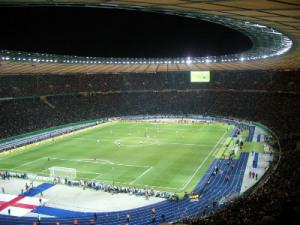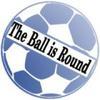A big welcome to these pages for Michael Miles who recent traveled to Berlin to see Hertha beat FC Köln.
This was my first visit to the Olympiastadion to see Hertha BSC (Berliner Sport-Club) since 2003. On that occasion I sat with about 40,000 other shivering souls marvelling at how the Germans could continue to put on a football match while much of the stadium was a building site preparatory to the 2006 World Cup.

Thoughts drifted toward our own beloved “stadium of legends”, Wembley. That had closed in October 2000, with a new stadium due to open in 2003. With all the disputes and wrangling, the old Wembley was not even demolished until 2003, and as many a travelling fan can testify, did not properly open for business until the 2007 FA Cup Final.
I had paid 37 euros for a seat in the “tribune” area, parallel with the edge of the penalty area. It would only have been 13 euros to “sit” with the home fans in the “Ostkurve”, though stand would have been more like it. They kept up a constant round of cheering and flag waving and it made for a great atmosphere.
The programme was 2 euros for a publication comparable to most you will find sold in the English Premiership for £3 upwards. But there didn’t appear to be many takers. I bought mine at a Hertha merchandise stand but didn’t come across any other sellers, and didn’t see any other fans clutching theirs.
The Olympiastadion holds 76,000 and staged six games during tie 2006 World Cup, including the Final, and hosts the German Cup Final and internationals. It is set in huge grounds built as a vast sports complex for the 1936 Olympics. The Marathon Gate with its clock tower remains in place after the most recent overhaul. Hertha have played there since 1963 when they became an inaugural member of the new professional national league-the Bundesliga.
Their own most recent playing history has been patchy. After a successful campaign in 2008-09, finishing in fourth place and remaining in the title race up until the second to last match day, they finished the following season bottom of the Bundesliga. However their sojourn in the 2. Bundesliga was to last only one season, and they secured promotion by winning 1-0 at MSV Duisburg with three match days to go.
The man in charge now is one-time Liverpool defender Markus Babbel. (Though he is listed as Trainer, not Manager.) He joined them in June 2010, taking them back to the Bundesliga at the first attempt. Before the Cologne game they sat in 12th place (from 18), a record which included a 2-1 victory away to Champions Borussia Dortmund. In a league with the highest average attendances in Europe, Hertha are averaging almost 54,000 this season. There were almost another 59,491 there on Saturday for a game scheduled for a 6.30 kick-off for live T.V. coverage.
Hertha were 3-0 up inside 34 minutes and the game was all but over. The first two goals were scored by centre-forward Lagogga, though the star of the show was Number 17 Anis Ben-Hatira . Operating on the left side of the Hertha midfield, for the first goal he beat three defenders, taking the ball virtually to the edge of the Cologne six-yard box before cutting it back for an easy tap-in. For the second it was his precise cross that landed on the head of Lagogga two yards from goal.
However the best goal was the third and last, and I’m sure will find its way to any German “Goal of the Season” collection. A free kick wide on the right and ten yards inside the Cologne half was met on the volley by Raffael on the left edge of the penalty area. It even brought Markus Babbel to his feet. Until this moment of brilliance he had spent the preceding 36 minutes seated among his assistants.
3-0 up at half-time Hertha inevitably sat back in the second half, but Cologne looked unable to do much to reduce the deficit. Apart from a one-on-one which goalkeeper Kraft saved with his feet, they created little. Playing up front for them was German international Lukas Podolski but he, along with his colleagues, and several thousand travelling fans, seemed to accept the task was beyond them long before the referee’s final whistle.
Listed in the match programme were all the Hertha players and trainers. Also listed, wearing number 92 was Herthinho, listed as the Joker-Mascot to you and me. (He even has his own web page.) Perhaps they send him on to confuse the opposition.

